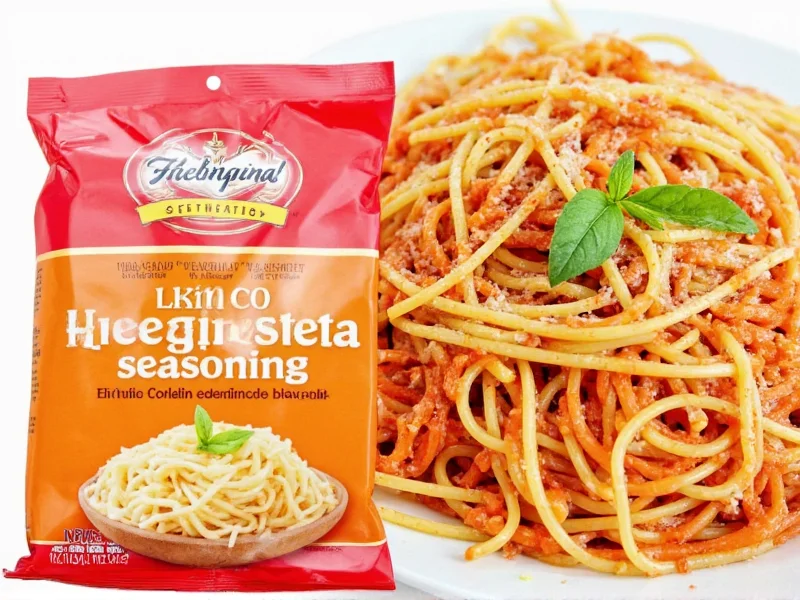Spaghetti seasoning packets offer a quick solution for flavoring pasta dishes, but many home cooks wonder what exactly goes into these convenient little envelopes and how to get the most from them. While brands vary, most commercial spaghetti seasoning packets share similar core ingredients designed to mimic traditional Italian-American spaghetti sauce flavors.
What's Inside Spaghetti Seasoning Packets
Examining the ingredient list reveals what gives these packets their characteristic flavor profile. Most contain:
| Common Ingredients | Typical Percentage | Flavor Contribution |
|---|---|---|
| Salt | 30-40% | Base flavor enhancer, preservative |
| Garlic Powder | 15-25% | Pungent, savory depth |
| Onion Powder | 10-20% | Sweetness, aromatic base |
| Oregano | 8-15% | Earthy, slightly bitter Mediterranean note |
| Basil | 5-12% | Sweet, slightly minty herbal note |
| Parsley | 3-8% | Fresh, grassy background note |
| Red Pepper Flakes | 1-5% | Subtle heat and complexity |
How Spaghetti Seasoning Packets Work
The science behind these seasoning blends lies in the Maillard reaction and umami enhancement. When added to cooking sauce or directly to pasta, the dried ingredients rehydrate and release their flavor compounds. The salt content helps extract moisture from tomatoes in sauce, concentrating flavors while the garlic and onion powders provide consistent flavor without burning that can happen with fresh versions.
Understanding spaghetti seasoning packet ingredients helps explain why some brands taste better than others. Higher quality packets use more whole herb pieces rather than just ground powders, which retain more essential oils and flavor compounds. The ratio of sweet herbs (basil) to earthy herbs (oregano) significantly impacts the final flavor profile.
Using Spaghetti Seasoning Packets Effectively
For best results with spaghetti seasoning packet uses beyond pasta, consider these professional tips:
- Add early in cooking: Incorporate the seasoning when sautéing onions and garlic to allow flavors to bloom in the oil
- Bloom in oil: For spaghetti seasoning packet sodium content reduction, mix the dry seasoning with 1 tsp olive oil before adding to dishes
- Balancing acidity: If your sauce tastes too acidic, the seasoning packet alone won't fix it—add a pinch of sugar
- Customize: Enhance store-bought spaghetti seasoning packets with fresh herbs for more complex flavor
Store-Bought vs. Homemade Spaghetti Seasoning
While convenient, commercial spaghetti seasoning packets often contain anti-caking agents, preservatives, and higher sodium levels than necessary. A basic homemade spaghetti seasoning recipe gives you complete control over ingredients and flavor balance.
The spaghetti seasoning packet vs Italian seasoning difference matters: Italian seasoning typically contains more basil and less garlic, while spaghetti-specific blends emphasize garlic and tomato-friendly herbs. For authentic flavor, adjust your blend based on whether you're making meat sauce, marinara, or vegetarian pasta.
Creating Your Own Superior Blend
Make a versatile homemade spaghetti seasoning with this simple recipe that serves as the best spaghetti seasoning packet alternative:
Basic Homemade Spaghetti Seasoning Recipe
2 tbsp dried oregano
2 tbsp dried basil
1 tbsp garlic powder
1 tbsp onion powder
1 tsp dried parsley
1 tsp red pepper flakes (optional)
1 tsp black pepper
1 tsp sugar (helps balance acidity)
2 tsp salt (adjust to taste)
Mix thoroughly and store in an airtight container. This blend makes approximately 6 servings—equivalent to six commercial spaghetti seasoning packets. The spaghetti seasoning packet nutrition facts for this homemade version show significantly less sodium and no preservatives compared to store-bought options.
Creative Uses Beyond Spaghetti
Don't limit spaghetti seasoning packets to just pasta dishes. These versatile blends work well for:
- Meat rubs: For chicken, pork, or beef before roasting
- Vegetable seasoning: Toss with roasted vegetables
- Soup enhancer: Adds depth to tomato-based soups
- Homemade breadsticks: Mix with olive oil for dipping
- Pizza sauce base: Combine with tomato paste
Troubleshooting Common Issues
When working with spaghetti seasoning packets, these solutions address frequent problems:
- Too salty: Balance with a splash of vinegar or lemon juice, which counteracts saltiness without diluting flavor
- Flat flavor: Add a small piece of Parmesan rind while sauce simmers to enhance umami
- Bitter taste: Stir in 1/2 tsp sugar or a grated carrot to neutralize bitterness from overcooked tomatoes
- Weak aroma: "Bloom" the seasoning in olive oil for 1-2 minutes before adding liquids
When Homemade Makes Sense
Consider making your own blend when:
- You need to reduce sodium for dietary reasons
- You want to avoid preservatives and anti-caking agents
- You're cooking in large quantities (homemade is more cost-effective)
- You prefer customizable heat levels
- You have dietary restrictions requiring specific ingredient control
For occasional use, quality store-bought spaghetti seasoning packets provide convenience without significant quality compromise. The key is understanding how to enhance them with fresh ingredients for restaurant-quality results at home.











 浙公网安备
33010002000092号
浙公网安备
33010002000092号 浙B2-20120091-4
浙B2-20120091-4